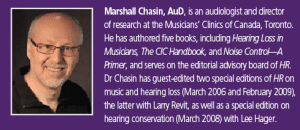Back to Basics | May 2014 Hearing Review
By Marshall Chasin, AuD
The CROS hearing aid, just 50 years old, has been laid to rest. It died peacefully after a prolonged change in the hearing aid industry that has relegated the once proud CROS hearing aid fitting to merely one that is equal to one of setting frequency response or gain. With modern technology, one can merely “program” a hearing aid to be able to communicate with its “pair” that sits on the opposite side of the head.
Based on a 1964 patent by Harry Teder at Telex, using a “sound tube” from one ear to the other, the first contralateral routing of signal (CROS) was accomplished.1 The patent did not mention a microphone on the opposite side of the head—the basic concept of a CROS. However, a year later, in 1965, Harford and Barry2 introduced CROS and BiCROS hearing aid fittings. Telex introduced a wireless eyeglass in 1975 and it proved to be very successful.
Wireless ear-to-ear technology was first introduced in 2004 by Siemens and was called e2e.3 At that time, it allowed a hearing aid user to be able to select a control on one hearing aid that simultaneously controlled some aspect of the other hearing aid. This early version was able to send a series of instructions from one hearing aid to the other hearing aid in a binaural fitting, such as the setting of compression features, and later, some features used in the setting of directional hearing aid characteristics. More recently, this included the desirable feature of being able to set the volume control on one aid that controlled both hearing aids, and a program switch in the other that controlled both hearing aids—a feature that is now available even in the small CIC hearing aids.
This “latest” wireless innovation, now a decade old, is ubiquitous in the hearing aid industry. One can listen to a telephone on one ear and receive a binaural signal in hopes of improving telephone communication. Virtually all hearing aid manufacturers now offer this capability.
And recently, wireless technology has progressed to a point where not only is control information being routed from one ear to the other, but the entire audio spectrum. One can program a hearing aid to have this full-spectrum wireless capability and the other to receive this wireless information. This is what the field has traditionally called the CROS (or BICROS) hearing aid.
If this is now a standard in the industry, CROS and BICROS fittings are now accomplished with little more than pushing a button or two in the programming software. In a CROS fitting, one would use software to turn off the hearing aid receiver in the “unaidable” ear and implement wireless communication to the other ear where the microphone has been disabled. In a BICROS fitting, both microphones would be left on. No longer are specially designed hearing aid shells and receivers required for a CROS/BICROS fitting. Two features of this new technology are apparent:
1) Setting up a hearing aid as a CROS or BICROS is equivalent in time spent to program a pair of hearing aids with all of the gain and output features being specified. It takes a similar amount of time as any other series of settings that are part of the fitting process.
2) The hearing aid on the “unaidable” ear is now a fully functional hearing aid and can be programmed as a CROS/BICROS or as a monaural hearing aid. All of the components and software found in any other hearing aid are present. Subsequently, the “second” hearing aid for the “unaidable” side is billed to the dispensing professional as another (second) hearing aid with its unique serial number and warranty information.
Given this reality, some manufacturers now sell a CROS or BICROS “hearing aid” as two separate hearing aids that, depending on the software settings, can be either two functional hearing aids in a binaural fitting or alternatively set up as a CROS or BICROS fitting. This is no different than selling two hearing aids where some characteristics can be wirelessly communicated between the devices in a binaural hearing aid fitting. With a potential CROS or BICROS hearing aid fitting, the dispensing professional is now billed the cost of two separate hearing aids.
The question arises whether the consumer or a third-party funder should pay for two hearing aids or for one hearing aid, or for something in between? Even if the hearing aid manufacturers charge two unit costs for the two hearing aids, should there be two full dispensing fees appended to the final cost of the hearing aid(s)?
Both hearing aids can be programmed to stand alone as fully functional hearing aids, and both hearing aids require software programming (and clinical time) by the hearing care professional. They also come with individual warranties and individual invoices, as if two hearing aids were dispensed. And it takes about the same time to program a hearing aid as a CROS or BICROS fitting as it does for a “conventional” between the ears wireless hearing aid fitting.
 References
References
1. Teder H. The first wireless CROS. Canadian Audiologist. 2014;1(2). Available at: http://canadianaudiologist.ca/issue/volume-1-issue-2-2014/column/stories-from-our-past.
2. Harford E, Barry J. A rehabilitative approach to the problem of unilateral hearing impairment: contralateral routing of signals (CROS). J Speech Hear Disord. 1965;30:121-138.
3. Herbig R, Barthel R, Branda E. A history of e2e wireless technology. Hearing Review. 2014;21(2):34-37.
Original citation for this article: Chasin M. Obituary: The CROS hearing aid (1964-2014). Hearing Review. 2014;21(5):12.






